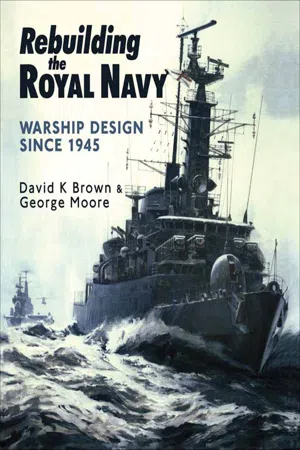
Rebuilding the Royal Navy. Warship Design Since 1945. By David K Brown & George Moore. Greenhill Books, Barnsley, 2024. ISBN 978-1-80500-066-2.
Reviewed by David Hobbs
This new paperback offers an excellent opportunity to obtain a book that gives valuable insight into warship design and development during a period that saw the end of steam propulsion in surface ships, the introduction of nuclear-powered submarines and a host of other technologies that are now in widespread use across the world.
The book is a paperback reprint of a work first published by Chatham Publishing in 2003 and republished by Seaforth Publishing in 2012. No changes have been made to the earlier text, illustrations or pagination.
D K Brown was a member of the Royal Corps of Naval Constructors and served within the department responsible for RN warship design for much of the period covered by this book. During his career with the Ship Department he worked, among other things, on submarine hydrodynamics and radiation shielding in nuclear submarines before becoming Chief Constructor.
In this position he worked on the preliminary design of all major surface warships. After promotion to Assistant Director he assumed responsibility for all ship designs and helped to introduce computer-aided design besides leading research into materials, structures and vulnerability. He was, thus, uniquely placed to write this book and his untimely death soon after its publication was a sad loss.
He enjoyed an international reputation and no single technical author has emerged to carry on his work. George Moore, his co-author, contributed the results his extensive archival research into wartime and immediate post-war construction projects and, as David Brown pointed out, to help overcome what he described as the sheer complexity of this book. George Moore wrote chapters 1 to 5 and David Brown wrote chapters 6 to 14. They both contributed to the appendices.
The ships described in this book cover the period from 1945 to a point just after the turn of the century; the Daring class destroyers and Queen Elizabeth class carriers, for instance, are mentioned only briefly as ‘glimpses into the future’ and this might disappoint some new readers.
It might have been more appropriate to change this edition’s secondary title to ‘Warship Design 1945 to 2000’ in order to make the text’s parameters more obvious. Within that timeframe, however, it remains an outstanding study of RN warship design and includes a number of projects that were designed but not built. These act as ‘bridges’ between classes that were built and provide fascinating insight into Admiralty thinking about warship design and construction, especially in the period immediately after 1945.
The chapters are laid out logically to show the range of designs with which the Admiralty sought the rebuild the RN in the post war world after 1945. Examples of cancelled projects include the Lion class battleships, Malta class aircraft carriers, a plethora of cruisers and the proposed Battle class radar picket destroyers. Some ships of the classes described saw service with the RAN, HMAS Melbourne of the Majestic class is described on page 23, for instance, and there are detailed descriptions of destroyer, frigate and submarine designs that will be of direct interest to readers in Australia.
A chapter is dedicated to reconstructions including the aircraft carriers Victorious, Hermes, Eagle and Ark Royal ; the cruisers Cumberland and Tiger and some destroyers. Type 15 destroyer conversions into anti-submarine frigates are described in a chapter dedicated to specialised frigate programmes.
For those who do not have access to the earlier editions, this new paperback offers an excellent opportunity to obtain a book that gives valuable insight into warship design and development during a period that saw the end of steam propulsion in surface ships, the introduction of nuclear-powered submarines and a host of other technologies that are now in widespread use across the world. David Brown served in the Dreadnought Project Team and later the SSBN Project at Bath and his lucid description of the early British nuclear submarine designs gives interesting background to those following the current development of AUKUS submarines in both the UK and Australia.
In some ways the original was the sequel to David Brown’s series of books which describe British warship design from 1800 onwards. It differs in several important respects, however, not only in being jointly written with George Moore.
The most significant difference is the fact that it was written before many of the documents relating to the ships described were removed from the UK secret list; the ‘Thirty-Year Rule’ that prevented details of weapons systems being made public until they were out of service. Twenty years on, significant relevant information may have been released into the public domain but we will have to await a new author capable of incorporating them into the story recounted so well by David Brown.
This is another caveat that new readers should bear in mind but it detracts very little from the high quality of this book as it was written. Information released since 2003 may in any case turn out to add little to the original text. I already have the complete, original, set of D K Brown’s books in my library but I have no hesitation in recommending this new edition to those who are not so fortunate.



